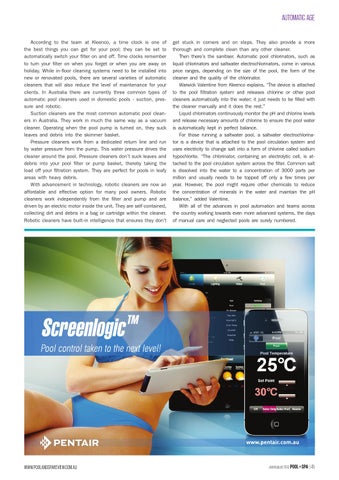AUTOMATIC AGE According to the team at Kleenco, a time clock is one of the best things you can get for your pool; they can be set to automatically switch your filter on and off. Time clocks remember to turn your filter on when you forget or when you are away on holiday. While in-floor cleaning systems need to be installed into new or renovated pools, there are several varieties of automatic cleaners that will also reduce the level of maintenance for your clients. In Australia there are currently three common types of automatic pool cleaners used in domestic pools - suction, pressure and robotic. Suction cleaners are the most common automatic pool cleaners in Australia. They work in much the same way as a vacuum cleaner. Operating when the pool pump is turned on, they suck leaves and debris into the skimmer basket. Pressure cleaners work from a dedicated return line and run by water pressure from the pump. This water pressure drives the cleaner around the pool. Pressure cleaners don’t suck leaves and debris into your pool filter or pump basket, thereby taking the load off your filtration system. They are perfect for pools in leafy areas with heavy debris. With advancement in technology, robotic cleaners are now an affordable and effective option for many pool owners. Robotic cleaners work independently from the filter and pump and are driven by an electric motor inside the unit. They are self-contained, collecting dirt and debris in a bag or cartridge within the cleaner. Robotic cleaners have built-in intelligence that ensures they don’t
WWW.POOLANDSPAREVIEW.COM.AU
get stuck in corners and on steps. They also provide a more thorough and complete clean than any other cleaner. Then there’s the sanitiser. Automatic pool chlorinators, such as liquid chlorinators and saltwater electrochlorinators, come in various price ranges, depending on the size of the pool, the form of the cleaner and the quality of the chlorinator. Warwick Valentine from Kleenco explains, “The device is attached to the pool filtration system and releases chlorine or other pool cleaners automatically into the water; it just needs to be filled with the cleaner manually and it does the rest.” Liquid chlorinators continuously monitor the pH and chlorine levels and release necessary amounts of chlorine to ensure the pool water is automatically kept in perfect balance. For those running a saltwater pool, a saltwater electrochlorinator is a device that is attached to the pool circulation system and uses electricity to change salt into a form of chlorine called sodium hypochlorite. “The chlorinator, containing an electrolytic cell, is attached to the pool circulation system across the filter. Common salt is dissolved into the water to a concentration of 3000 parts per million and usually needs to be topped off only a few times per year. However, the pool might require other chemicals to reduce the concentration of minerals in the water and maintain the pH balance,” added Valentine. With all of the advances in pool automation and teams across the country working towards even more advanced systems, the days of manual care and neglected pools are surely numbered.
July/August 2013 POOL + SPA
| 45
